A while ago Engine Builder ran a story on the popularity and basic dos and don’ts of stroker engines (
March 2007 Engine Builder). It received such great response that we are following up with a “real world” stroker engine buildup.
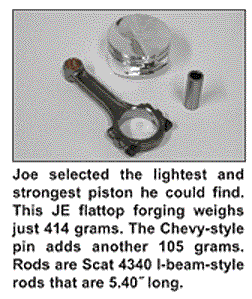
In this case, it is an engine combination that is so popular that it single handedly has given Ford guys the weapon they needed to finally topple the reign of the mighty Chevy 350 – a task that Ford could not accomplish with either its 351C or 351W!
Follow along as noted Chevrolet engine builder Joe Sherman shows us how anyone can screw one of these fire-breathers together with off-the-shelf-parts. In fact, Joe built two stroker small-block Fords – the first a pump gas street/strip engine that produced 530 hp on pump gas, the other, a 357 race motor that cranked out 751 hp with a single four barrel carb and over 800hp with two four-barrels. We will concentrate on the street engine because it has more general application.
Also, please keep in mind we will be showing a very specific build list of parts.
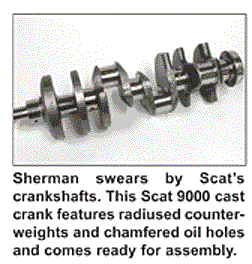
However, are these the only parts that will get the job done? Absolutely not. As you may recall from the March 2007 Engine Builder: Stroker Engine Resource Guide, a wide variety of configurations – “recipes,” if you will – can be used to make the final product. But what goes in to the engine will have a direct relationship to what comes out of it.
With that in mind, it’s appropriate to point out that Joe Sherman uses many parts suppliers. In case something isn’t available, he has an alternative source to keep the engine buildup moving forward.
Joe Sherman Racing in Santa Ana, CA. is one of those “boutique” engine shops that cater to local racers and street guys who have a real need for speed. It doesn’t matter if you bring him a Chevrolet, AMC, Oldsmobile or Ford, Sherman relies on his trusty flow bench, dyno and his 40-plus years of experience to put together a winning combination.
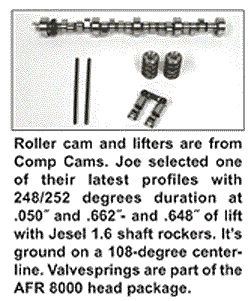
Unlike many engine builders, Sherman has a thorough understanding of the complete racecar package, as he and his sons have raced incredibly quick bracket cars for years. Sherman knows from first-hand experience how much power you need, and where in the powerband you need it.
Wringing every last ounce of useable power out of a given combination is his specialty; in fact, he won the first inaugural Popular Hot Rodding Engine Masters Challenge – kickin’ butt on pro engine builders from across the country. So when the “Engine Master” turned his attention to a pair of stroker Fords, Engine Builder wanted to be on hand to record the experience.
The plan was to build a 347 and a 357 off of the Ford 302 Windsor platform. Shermanator I was designed to run on pump gas, make 500 hp and not break the bank. Shermanator II is a flat-out, single four-barrel “no holds barred” race setup. The major differences between the two engines, aside from the slightly longer stroke for the 357, is that the 357 has higher compression, better-flowing cylinder heads, lighter rotating and reciprocating components and everything possible was done to reduce internal friction including two-ring pistons and extensive coatings.
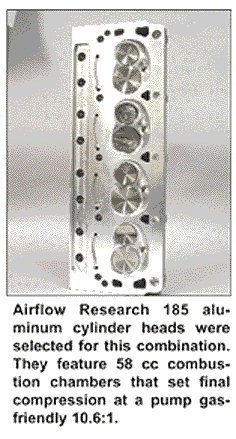
Initially the pump gas 347 was to be built around a budget rotating assembly. Joe ordered the parts and when the pistons arrived with several different styles of valve notches, Joe decided to revert to Plan B, using engine components he knew and trusted.
It would cost a little more, but knowing the engine would stand up to several seasons of 7,000-rpm abuse would more than make up for the difference in price. Joe is definitely on the frugal side, but he spends money where it counts – on anything that enhances reliability and power output.
The block is a late-model production 302. The reason we mention this is that later blocks have slightly different deck heights than early blocks. Joe’s block ended up with an 8.18″ deck height after final machining.
After inspecting the O.E. main bearing caps he made the observation that they looked a little “delicate,” so he installed a CAT main bearing girdle that requires no machining. It helps retain the Scat 9000 cast crank that features radiused
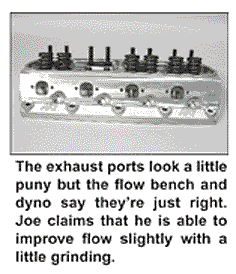
counterweights and chamfered oil holes. Joe has used a number of Scat cranks and swears by their quality, durability and price. The crank rotates in Federal-Mogul Competition Series bearings with clearances kept on the tight side of recommended tolerance.
Scat got the call for the connecting rods as well. Joe selected a set of 4340 I-Beam-style rods that measure 5.40″ center-to-center. The longer rods (stock measure 5.09″) allow the pistons to clear the stroker crankshaft counterweights and provide a more favorable rod ratio. These rods come with ARP bolts and are bushed and drilled on the pin end for oiling.
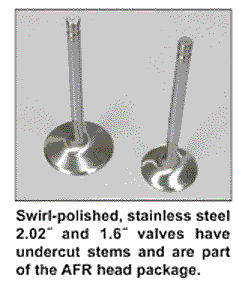
One of Joe’s “speed secrets” is that he always uses the lightest and strongest piston available, because it takes power to stop and accelerate a piston twice per crankshaft revolution. The JE forging (p/n 188703) fills Joe’s requirements perfectly. They feature a flattop design and weigh a mere 414 grams plus another 105 grams for the Chevy-style premium piston pin.
A set of 1/16″-, 1/16″- and 3/16″ file-fit Speed Pro rings provide the ring seal and glide on cylinder walls that are finished with an 820-grit stone. The oil ring is a low-tension design but has enough oil control for a street engine without the assist of a vacuum pump. The remainder of the bottom end consists of a stock pressure and volume Melling M-68 oil pump and a Stef’s welded aluminum, high-capacity oil pan.
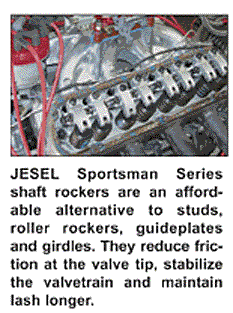
Joe is constantly doing R&D on camshaft profiles to find more horsepower, however, he’s really pleased with Comp Cams’ latest series of solid roller lifter profiles. The cam he selected for this pump gas 347 measures 248- and 252-degrees duration at .050″ of lift, and .662″- and .648″ of lift at the valve with 1.6 ratio Jesel shaft rockers. It’s ground on a 108-degree centerline and installed in the motor “straight up.”
Due to the aggressive profile on this cam, Joe feels that the effective duration is more than the specs would indicate. In fact, the dyno tests revealed that this engine combination could use a little less cam timing because the actual compression is only 10.5: 1. When the valve lash was increased (decreasing duration) it picked up the power.
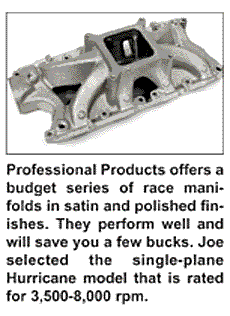
Jesel shaft rockers may sound extravagant for a pump gas street engine, but not when you take a closer look. Jesel’s Sportsman Series (SS) shaft rockers retail for just $750 which is no more than you would pay for a set of good aftermarket studs, roller rockers, guideplates and stud girdle. Plus you get all of the advantages of shaft rockers such as better geometry from the rocker’s longer pivot length, the stability of the shaft that ties it all together and hi-strength adjusters that maintain valve lash longer.
The real key to making 530 hp from 347 cubic inches on pump gas is the Airflow Research (AFR) aluminum cylinder heads. AFR is selling these heads like hotcakes. They come in a few different sizes and options. Joe selected AFR 185s for this engine. They feature 2.02″/1.60″ stainless steel valves and 58 cc combustion chambers that set the compression ratio at 10.6:1 with the .053″ Cometic head gasket Joe is running (more on that later).
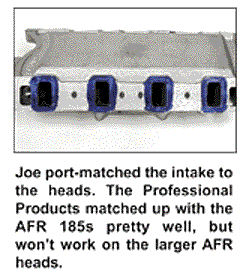
Joe ordered the optional AFR 8000 roller cam spring package that includes springs set at 210-pounds on the seat and 550-pounds open. They will accommodate valve lifts to .670″ and come with titanium valvespring retainers.
Joe slapped the heads on the flow bench and performed some minor porting but says he’s amazed at how good these heads are out of the box. He said that you can make slight improvements in flow, maybe 5-10 cfm, but the average guy will most likely hurt the flow numbers, so leave them alone. The heads are held in place by ARP hardware.
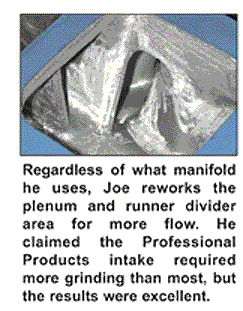
Things got interesting when Joe got to the 347’s intake system. He heard that there were some excellent components on the market that would make the power numbers he wanted and still allow him to save a few bucks in the process. He selected a Professional Products Hurricane single-plane manifold that is available in a satin or polished finish. It has an rpm range of 3,500-8,000 rpm and has some neat features such as integral bosses that can be drilled and tapped for nitrous nozzles. It retails for about $50 less than similar manifolds sold by major manifold makers, but produced good power on the street 347.
Joe went in and smoothed the port dividers in the plenum area, a process he does regardless of whose manifold he uses; the Hurricane just needed a little more grinding than usual to meet his approval.
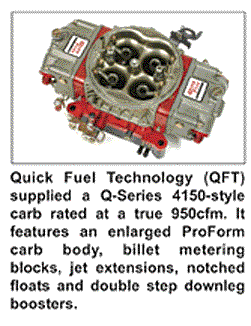
The carburetor choice was a big surprise. Joe contacted Quick Fuel Technology (QFT) in Bowling Green, KY. He gave them his engine specs and application and let them design a carburetor to match the application. No wimpy 750 here! QFT provided one of its Q-Series 950 cfm 4150s.
They start with a ProForm carb body, bore the venturis out to 1.450″, install double step downleg boosters and a billet baseplate with 1-3/4″ throttle blades. The throttle shafts are “slabbed” and use button-head screws to improve flow.
On the metering side, QFT two-circuit billet metering blocks are installed with four-stage emulsion. Other features include notched floats, jet extensions and high-flow squirter screws. QFT’s Q-Series carbs are streetable with timed vacuum ports, PCV ports and full vacuum ports. However, they don’t have a choke. With a $639 retail price the Q-Series is approximately $300 less than a competitive custom race carb.
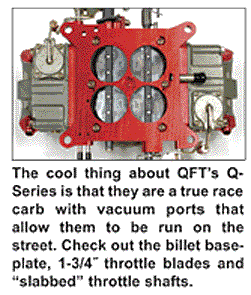
Joe assembled the 347 with Fel-Pro gaskets and ARP fasteners. Everything went together as planned, except the pistons ended up .010″ above the deck. Joe says he had brain fade and overlooked that he was using an early block with the shorter deck height. No problem! His ace-in-the-hole was the Cometic Multi Layer Steel (MLS) gasket that is available in thicknesses for .027″- to .120″ the .054″-thick gasket was just the ticket to establishing the correct clearances.
Other details include a Ford distributor set up with an Ignitioneering mag pickup trigger mechanism and an MSD ignition box and a set of SVO valve covers to add a bit of style.
Joe hooked the 347 to his trusty Superflow dyno, installed 1 ?? dyno headers and 3″ Magnaflow mufflers. He threw in a set of Accel 784 sparkplugs gapped at .045″ and set the timing for 38-degrees total. A set of #78 primary and #86 secondary jets were selected (after a few warm-up pulls) to meter the 91-octane Unocal gas. Joe made more than 14 dyno pulls in all, optimizing ignition timing, valve lash and jetting.
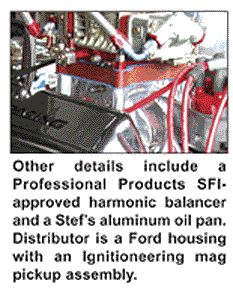
The final result was 527.0 horsepower at 7,000 rpm, and 443 lb. ft. of torque at 5,600 rpm. An amazing side note is that the torque never dropped below 400 ft.lbs. from 4,800-6,800 rpm. (Joe subsequently experimented with a larger 1050 cfm QFT carb and larger cam and produced 530.2 horsepower at 7,000 rpm but slightly less torque.)
The formula is pretty simple, and can be applied to any engine:
-
- Select cylinder heads with enough flow to match the engine displacement.
- Keep the rotating assembly as light as possible.
- Increase rod length if possible.
- The induction system needs to be larger than you might think.
What Joe Sherman has put together here on a budget is a pump gas small-block that has an ideal power curve that most of us can relate to.
|
SHERMANATOR SOURCES
Joe Sherman Racing 2302 W. Second St. Santa Ana, CA 92703 714 542-0515 www.joeshermanracing.com Air Flow Research 10490 Ilex Ave. Pacoima, CA 91331 818-890-0616 ARP 1863 Eastman Ave. Ventura, CA 93003 800-826-3045 www.arp-bolts.com Cometic Gasket 8090 Auburn Rd. Concord, OH 44077 440-354-0777 www.cometic.com Comp Cams 3406 Democrat Rd. Memphis, TN 38118 800-999-0853 www.compcams.com Federal-Mogul Performance 26555 Northwestern Hwy. Southfield, MI 48034 248-354-2700 www.federal-mogul.com JE Pistons 15312 Commercial Lane Huntington Beach, CA 92649 714-898-9763 www.jepistons.com Jesel 1985 Cedarbridge Ave. Lakewood, NJ 08701 732-901-1800 www.jesel.com Professional Products 12705 S. Van Ness Ave. Hawthorne, CA 90250 323-754-1287 www.professional-products.com Quick Fuel Technology 2352 Russellville Road Bowling Green, KY 42101 270-793-0900 www.quickfueltechnology.com Scat Crankshafts 1400 Kingsdale Ave. Redondo Beach, CA 90278 310-370-5501 www.scatcrankshafts.com Stef’s Fabrication Specialties 693 Cross Street Lakewood, NJ 08701 732-367-8700 |













